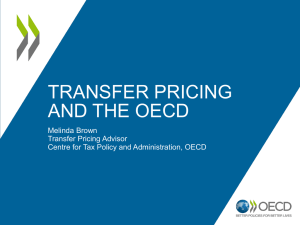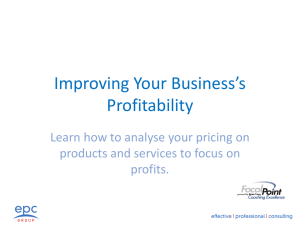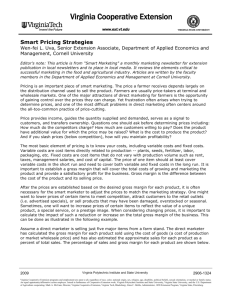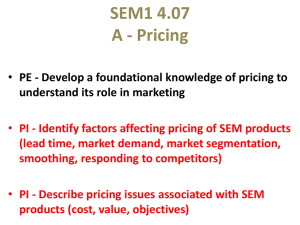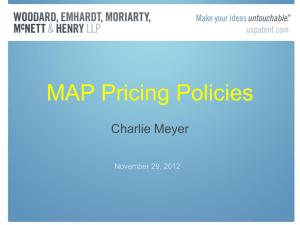Ch 3
advertisement
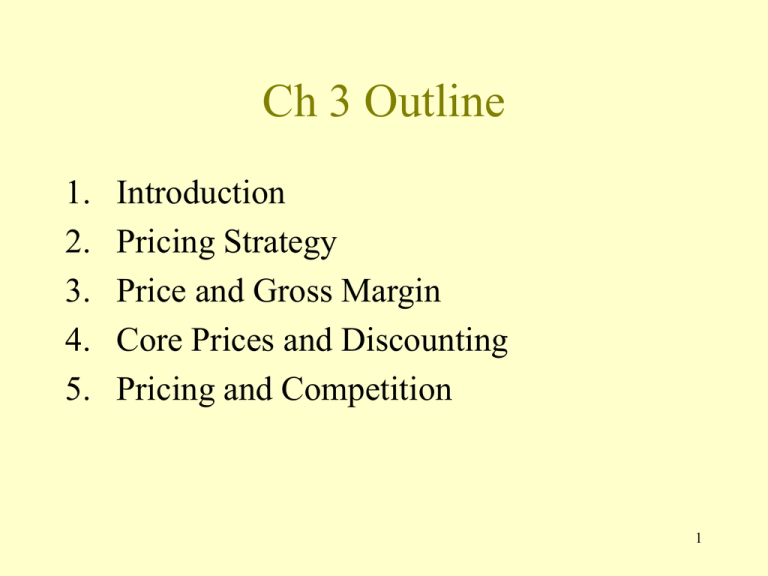
Ch 3 Outline 1. 2. 3. 4. 5. Introduction Pricing Strategy Price and Gross Margin Core Prices and Discounting Pricing and Competition 1 3-1 Introduction • The basic business process that underlies all ventures, regardless of their industry or size, is: – R – C = P (revenue minus cost equals profit). • Understanding the business process is critical for entrepreneurs and for people who practice the skills of entrepreneurism. – One of the last considerations that the entrepreneur takes into account is the price that will be charged to customers. – Yet, setting price for products and services is a critical factor in the success of a venture. 2 3-1 Introduction (cont.) • Problem with cost-plus pricing: Customers care about the price they have to pay for products and services and the value they receive for that price. – If the entrepreneur uses the cost-plus pricing approach: • The price is set too high and the customer does not buy. • The price is set too low and each sale returns less profit to the business than is possible. 3 How Customer Demand Affects Pricing • The Elasticity of Demand – The degree to which a change in price affects the Price quantity demanded. Inelastic – Elastic Demand • Demand that changes significantly when there is a change in the price of the product. Elastic – Inelastic Demand • Demand that does not change significantly when there is a change in the price of the product. Demand 4 3-2 Pricing Strategy • Price strategy is an attempt to affect demand through alteration of prices. • An effective price strategy is responsive to the type of demand present in the market. 5 3-3 Price and Gross Margin • Entrepreneurs must also monitor the effect of their pricing strategy on the firm’s gross margin. – Gross margin is the difference between the selling price of a product or service and the amount the entrepreneur had to pay for the raw materials that make up that product or service. – Gross margin is expressed as a percentage of revenue, using the following equation: 6 • 3-3 Price and Gross Margin (cont.) A price reduction usually results in a reduction in gross margin. – Increased sales volume can lead to a reduction in the average cost of goods sold because suppliers will often provide discounts to clients that buy in large volumes. • A price increase that increases sales volume—or, at least, does not reduce sales volume—is a powerful tool for profit. – Businesses that are able to raise prices without cost increases and without sacrificing sales volume possess is called pricing power. 7 3-4 Core Prices and Discounting • One of the most important considerations in any price strategy is to protect the core prices of the business. – The airline industry provides a good example of the concept of core price protection. – Another common method that companies use to protect their core pricing is through product downsizing. 8 3-4 Core Prices and Discounting – Discounting is the most widely used price strategy. • When the discounted prices are offered for a limited time, the situation is usually referred to as a sale. 9 • 3-4a Pricing and Finance Discounting The U.S. economy has grown to its present size in large part based on the use of credit. – Because the use of credit has become so pervasive, credit terms have become an important part of price and volume strategy. • The furniture and appliance industries offer examples of the use of interest rate discounting. • In 2000 the automotive industry instituted a novel discounting strategy. – When purchasing a car, the customer was not required to make any payments for a period of one year. – Payments toward the vehicle began in the second year through what is known as a level payment plan. 10 • 3-4a Pricing and Finance When Discounting starting a new business,(cont.) many entrepreneurs are tempted to set their prices below the general market. The intent of such a strategy is to attract customers by offering them a price advantage. – Price is often regarded to be the advantage that customers will respond to most readily. – Sometimes this price strategy will lead to the opposite reaction. • • Customer perception is an important factor in the success of any business. Established competitors may also respond by offering discounts, which could cause a price war the new entrant will loose. 11 3-5 Pricing and Competition • Pricing strategy should never be executed without thought to the reaction of competitors. – If a price strategy is effective and encroaches on the competitor’s market share, there is likely to be a vigorous reaction. • In an elastic market, a price change may bring new customers into the market. – When a price reduction is based on lower costs and the price move results in a larger number of buyers in the market, the strategy is a great success. • The airline industry is an example of the price reduction cycle in an elastic market. 12 3-5 Pricing and Competition (cont.) • The reverse side of the success of price reductions based on lowered costs and expanded market is also demonstrated in the computer and consumer electronics market. – Discounters look for markets in which consumers are price sensitive. 13



